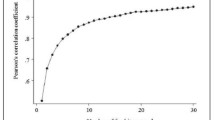Abstract
This study aimed to explore how possible it would be to reduce the length of a food-frequency questionnaire (FFQ) while maintaining adequate accuracy. This FFQ was validated in women in a previous study by our group, whereas the validation in men was one of the aims of the present study. A 15-item FFQ was administered to 136 men and 211 women (age range 25–75 years) recruited by proportional age-stratified sampling, who agreed to fill in a 14-day diet diary. For the intermediate version of the FFQ we considered only eight items in women and 10 in men. For the very short version we considered only three items. The positive likelihood ratio was markedly lower for the very short version (men = 1.2 and women = 1.5) with respect to the intermediate version (men = 6 and women = 6.3) and the 15-item version (men = 19.6 and women = 19.9). The specificity of the very short version was low (22.2% for men and 35.2% for women). The area under ROC curve of the three-item FFQ was significantly lower with respect to the other two versions. In conclusion, our study suggests that the shortest version of the FFQ could be usefully employed only in those clinical settings where the main objective is the identification of individuals who do not have a low calcium intake. ROC analysis and posttest probability calculated by positive likelihood ratio may represent an optimal method for assessing the accuracy of FFQs.


Similar content being viewed by others
References
Nordin BE (1997) Calcium and osteoporosis. Nutrition 13:664–686
Lau EM, Cooper C (2001) Risk factors for osteoporosis in Europe. J Bone Miner Metab 19:142–145
Heaney RP (2002) The importance of calcium intake for lifelong skeletal health. Calcif Tissue Int 70:70–73
Heaney RP (2007) Bone health. Am J Clin Nutr 85(Suppl 1):S300–S303
Boonen S, Vanderschueren D, Haentjens P, Lips P (2006) Calcium and vitamin D in the prevention and treatment of osteoporosis—a clinical update. J Intern Med 259:539–552
Briefel RR, Johnson CL (2004) Secular trends in dietary intake in the United States. Annu Rev Nutr 24:401–431
US Department of Agriculture, US Department of Health and Human Services (2005) Dietary guidelines for Americans, 6th edn. US Government Printing Office, Washington, DC
Kanis JA, Johansson H, Oden A, De Laet C, Johnell O, Eisman JA (2005) A meta-analysis of milk intake and fracture risk: low utility for case finding. Osteoporos Int 16:799–804
Cade J, Thompson R, Burley V, Warm D (2002) Development, validation and utilisation of food-frequency questionnaires—a review. Public Health Nutr 5:567–587
Cade JE, Burley VJ, Warm DL, Thompson RL, Margetts BM (2004) Food-frequency questionnaires: a review of their design, validation and utilisation. Nutr Res Rev 17:5–23
Marks GC, Hughes MC, van der Pols JC (2006) The effect of personal characteristics on the validity of nutrient intake estimates using a food-frequency questionnaire. Public Health Nutr 9:394–402
Magkos F, Manios Y, Babaroutsi E, Sidossis LS (2006) Development and validation of a food frequency questionnaire for assessing dietary calcium intake in the general population. Osteoporos Int 17:304–312
Cummings SR, Block G, McHenry K, Baron RB (1987) Evaluation of two food frequency methods of measuring dietary calcium intake. Am J Epidemiol 126:796–802
Blalock SJ, Currey SS, DeVellis RF, Anderson JJ, Gold DT, Dooley MA (1998) Using a short food frequency questionnaire to estimate dietary calcium consumption: a tool for patient education. Arthritis Care Res 11:479–484
Sebring NG, Denkinger BI, Menzie CM, Yanoff LB, Parikh SJ, Yanovski JA (2007) Validation of three food frequency questionnaires to assess dietary calcium intake in adults. J Am Diet Assoc 107:752–759
Severo M, Lopes C, Lucas R, Barros H (2009) Development of a tool for the assessment of calcium and vitamin D intakes in clinical settings. Osteoporos Int 20:231–237
Elliott ME, Meek PD, Kanous NL, Schill GR, Weinswing PA, Bohlman JP (2002) Osteoporosis screening by community pharmacists: use of National Osteoporosis Foundation resources. J Am Pharm Assoc 42:101–111
Blalock SJ, Norton LL, Patel RA, Cabral K, Thomas CL (2003) Development and assessment of a short instrument for assessing dietary intakes of calcium and vitamin D. J Am Pharm Assoc 43:685–693
Montomoli M, Gonnelli S, Giacchi M, Mattei R, Cuda C, Rossi S (2002) Validation of a food frequency questionnaire for nutritional calcium intake assessment in Italian women. Eur J Clin Nutr 56:21–30
Willet WC (1998) Nutritional epidemiology, 2nd edn. Oxford University Press, New York
Carnovale E, Marletta L (eds) (1997) Food composition tables. Istituto Nazionale della Nutrizione. EDRA, Milan
Salvini S, Parpinel M, Gnagnarella P, Maissonneuve P, Turrini A (1998) Banca dati di composizione degli alimenti per studi epidemiologici in Italia. European Institute of Oncology, Milan
Bland JM, Altman DG (1986) Statistical methods for assessing agreement between two methods of clinical measurement. Lancet 1:307–310
Sackett DL, Straus SE, Richardson WS, Rosenberg W, Haynes RB (2000) Evidence-based medicine. How to practice and teach EBM, 2nd edn. Churchill Livingstone, London
Hanley JA, McNeil PJ (1982) The meaning and use of the area under a receiver operating characteristic (ROC) curve. Radiology 143:29–36
Hanley JA, McNeil PJ (1983) A method of comparing the areas under receiver operating characteristic curves derived from the same cases. Radiology 148:839–843
Pewsner D, Battaglia M, Minder C, Marx A, Bucher HC, Egger M (2004) Ruling a diagnosis in or out with “SpPIn” and “SnNOut”: a note of caution. BMJ 329:209–213
Author information
Authors and Affiliations
Corresponding author
Rights and permissions
About this article
Cite this article
Gonnelli, S., Rossi, S., Montomoli, M. et al. Accuracy of Different Reduced Versions of a Validated Food-Frequency Questionnaire in Italian Men and Women. Calcif Tissue Int 85, 221–227 (2009). https://doi.org/10.1007/s00223-009-9264-4
Received:
Accepted:
Published:
Issue Date:
DOI: https://doi.org/10.1007/s00223-009-9264-4




